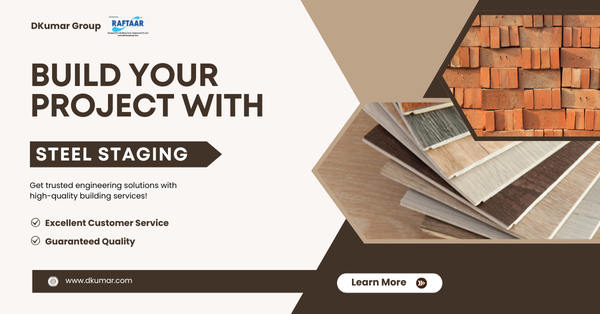Angled Beams: A Versatile Steel Component

Have you ever wondered how huge bridges and skyscrapers stand tall and are able to handle massive weight? Well, the answer for this lies in the unseen foundation of these structures, that is, steel beams. In all the major structures, like bridges and skyscrapers, angled beams play a vital role in offering great strength and versatility.
In the construction and engineering sectors, there is a constant challenge of finding the perfect structural material that can be used in diverse projects. Traditional materials often fail to offer the strength, versatility, and durability that various modern projects require. The limitations of these materials lead to increased costs, limited design possibilities, and structural failures.
This is where angled beams come into the picture. Made from high-quality steel, angled beams offer a compelling and long-term solution to these challenges. Angle beams have unique properties and designs, which makes them a reliable and ideal choice for a wide range of projects, especially those that include intricate details and the building of huge structures.
So, in this blog, we will discuss angled beams and their major applications. Read the blog till the end to understand the use of angled beams, and multiple applications, from towering skyscrapers to intricate industrial machinery, and its importance for construction needs.
What are Angled Beams?
Angled beams are steel sections with a unique L-shape, hence they are also known as L-beams or angle irons. They are formed by joining two perpendicular steel flanges, creating a unique shape that can be used in different orientations and providing flexibility in design and construction.
The L-shape of angled beams helps in easy connection with other components used in structural design. This adds the versatility component of angled beams and enables them to be used in a wide range of applications. The component of strength in angled beams come from the cross-sectional shape, which effectively helps in distributing the loads.
Angled beams are also easy to install as they can be easily assembled using welds, and bolts for fastening methods. The use of installation of angle beams reduces the installation time and need for specialized labor, which makes them a cost-effective solution.
Applications of Angled Beams
Floor and Roof Systems
Angled beams, with their strength characteristics and unique shape, play a crucial role and are indispensable components in floor and roof systems. By using angled beams in the design, it is much easier to create structures that are durable, stronger, and able to stand the existing upcoming challenges of modern construction projects.
They can be used as follows:
- Rafters: In roof systems, angled beams are used as drafters to provide support for roof covering. If the shape allows for efficient connection to the wall, creating a secure structure and ensuring the roof’s structural stability.
- Joints: Angled beams serve as effective joints to connect other structural elements as their shape allows for secure connections, ensuring the structural integrity of the floor and roof system.
- Contribution to Reinforcing Concrete Floors and Roofs: By embedding angled beams within the structures, you can significantly increase the strength and stiffness, making them more resistant to loads and deformations. Apart from this, angled beams also reduce the need for often costly maintenance and repairs by enhancing the overall durability and lifespan of the structures and allowing for a wide range of innovative design possibilities.
Machinery Frames
Angled beams play a crucial role in the construction of reliable machinery frames as their high strength-to-weight ratio and fabrication helps in ensuring precise alignment and supporting heavy machinery.
- Precise Alignment: Angled beams can be precisely cut and welded to form precise frames. This ensures the right alignment of the machinery components which leads to reduced maintenance requirements and optimal performance.
- Shock Absorption: Angled beams can be designed to absorb shock loads, which helps protect sensitive components from damage. This particularly helps heavy-duty machinery that is subject to impact loads such as forging machines.
- Rigidity and Stability: Angled beams form a rigid and stable framework when combined with other structural elements, making them ideal to withstand dynamic clothes and vibrations generated during construction.
- Corrosion Resistance: Angled beams are resistant to collision, which makes them ideal for using harsh industrial environments. This leads to the long-term reliability and durability of the machinery frame.
Angled beams are used in multiple industrial settings, which include conveyor systems and industrial robots. They are used to create the frames of conveyor systems, which ensures smooth material flow by providing support to conveyor belts. When it comes to industrial robots, they need rigidity and stability to perform complex tasks with precision, and this is where angled beams help.
Structural Framing
Angled beams are highly used to provide support and stability to buildings, and all the other structures. They are extensively used for bracing in different structures as they can be installed vertically, horizontally, or diagonally to provide lateral support that allows the structure to withstand buckling.
The high strength-to-weight ratio of angle beams significantly improves structural stability to withstand earthquakes and makes some an ideal choice for regions prone to seismic activity or high winds. To know more about bracing and how it helps to withstand earthquake forces, you check out our other blog.
They are also used to efficiently distribute heavy loads across the structure as the unique L-shape allows them to transfer loads, minimize stress, and concentration, and ensure the overall safety of the structure.
Signage and Hoarding
Angled beams, being a seal component, help in supporting large and complex signage installations. They provide a reliable framework for signage and holding structures, allowing them to support heavy banners, signage boards, and other display materials.
The L-shape of angled beams helps in creating Raju triangular structures, which are highly effective and efficient in resisting wind loads. Apart from this, angled beams have a resistance to temperature fluctuations, which helps in ensuring that even in extreme weather conditions, the structural durability and integrity of signage and hoarding remain just fine.
Conclusion
In this blog, we have delved into the multiple applications of angled beams in steel construction. From their foundational role in structural framing to intricate details to machinery frames and signage, angled beams are indispensable components in the modern construction era.
Unique properties of angle beams, such as durability, versatility, ease of installation, and strength. Engineers can use their potential to create innovative and efficient structures. Whether it’s a visually striking signage installation, a robust industrial facility, or a skyscraper, angled beams act as the backbone that ensures stability and safety.
By embracing the power of angled beams, we can shape a future built on sustainability, strength, and aesthetic appeal. So, are you ready to leverage the power of angled dreams for your next project? Contact DKumar or visit our website today to discuss your specific needs and explore how our expertise in the steel industry can bring your vision to life.




